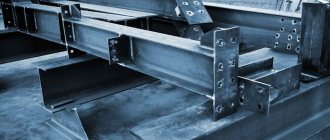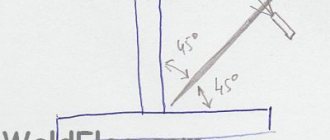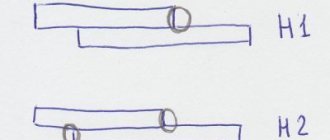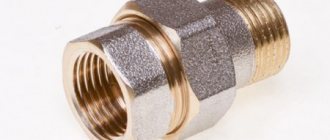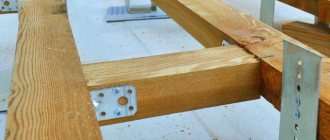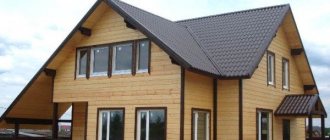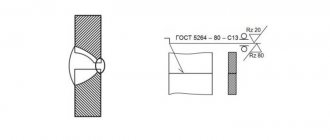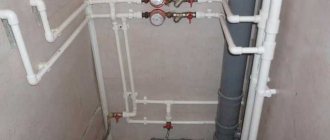In practice, the side of a square washer is taken to be 4.5d (where d is the diameter of the bolt).
The dimensions of square washers are taken according to the diameter of the bolts according to Table 3 (Fig. 2).
Table 3: Bolt range
| p/p | Bolt diameter (mm) | Sectional area (cm²) | Weight, kg | Bolt square washers dimensions (mm) | |||||||
| according to the rod, dbr | by cutting, dnt | by rod, Fbr | by cutting, Fnt | 1 linear meter of bolt | one nut | working bolts | coupling bolts | ||||
| hexagonal | square-rat-noy | dimensions, mm | weight of 1 puck, kg | dimensions, mm | weight of 1 puck, kg | ||||||
| 1 | 2 | 3 | 4 | 5 | 6 | 7 | 8 | 9 | 10 | 11 | 12 |
| 1 | 6 | 4,701 | 0,283 | 0,173 | 0,22 | 0,004 | 0,004 | 30x30x3 | 0,01 | — | — |
| 2 | 8 | 6,377 | 0,505 | 0,316 | 0,39 | 0,008 | 0,007 | 40x40x4 | 0,048 | — | — |
| 3 | 10 | 8,051 | 0,785 | 0,509 | 0,62 | 0,014 | 0,014 | 50x50x5 | 0,095 | — | — |
| 4 | 12 | 9,727 | 1,13 | 0,744 | 0,89 | 0,020 | 0,021 | 60x60x6 | 0,164 | 45x45x4 | 0,06 |
| 5 | 16 | 13,4 | 2,01 | 1,408 | 1,58 | 0,052 | 0,053 | 80x80x8 | 0,386 | 55x55x4 | 0,088 |
| 6 | 20 | 16,75 | 3,14 | 2,182 | 2,47 | 0,093 | 0,095 | 100x100x10 | 0,760 | 70x70x5 | 0,18 |
| 7 | 24 | 20,1 | 4,521 | 3,165 | 3,55 | 0,141 | 0,144 | 120x120x12 | 1,341 | 90x90x7 | 0,42 |
| 8 | 27 | 23,1 | 5,722 | 4,18 | 4,49 | 0,182 | 0,187 | 140x140x14 | 2,091 | 100x10 x8 | 0,591 |
| 9 | 30 | 25,45 | 7,065 | 5,06 | 5,55 | 0,291 | 0,297 | 160x160x15 | 2,93 | — | — |
| 10 | 36 | 30,80 | 10,17 | 7,44 | 7,99 | 0,496 | 0,506 | 190x190x18 | 4,957 | — | — |
The minimum distances between bolts and the minimum distances from the edges of the tree are established taking into account the permissible chipping stresses of the wood. This will be discussed in more detail in the following sections of the site.
In capital construction, when reliability and stability of the structure are required, bolts can be used only if special means (for example, staples) will prevent the occurrence of shear in the contact seams (node 33).
For example, calibrated holes can be used, i.e. such when the diameter of the hole is equal to the diameter of the bolt, or subsequent filling of the gap between the bolt shaft and the edges of the hole is carried out.
Bolts are used in structures that work in tension when suspending building elements (Fig. 3) and as non-load-bearing connections in the form of clamping bolts.
1.2. Connection on rod dowels
Rod dowels are cylindrical steel rods, usually without nuts and threads, which are driven into drilled holes with a diameter reduced by 0.2...0.5 mm (Fig. 3, item 6).
READ ALSO: Installation of rafter legs, ridge fastening units, fastening with a bolt-tightening
The tightening bolts (Fig. 3, item 1) have washers (Fig. 3, item 5) installed under the head (Fig. 3, item 2) and nut (Fig. 3, item 3).
It is recommended to install large and thick washers on both sides.
The use of rod dowels is of great importance for load-bearing connections, because with it, you can not be afraid of deformations due to the selection of gaps in the holes and creep of structures.
Connections using rod dowels allow you to achieve high performance: with a small area they can absorb relatively large loads.
They are best used for packages of boards, as well as for connecting to steel elements located inside the structure (node - 35).
The picture of node -34 shows an option for attaching the ridge truss assembly. The block braces are attached to the upper chord with four dowels. In the middle there are coupling bolts. The upper chords of the rafters are bolted to the ridge beam.
The sketch of node 35 shows an option for fastening a two-branch rack with a single crossbar. This fastening provides an almost rigid connection of a two-branch rack with a single crossbar using dowels located along the ring.
Tightening bolts provide a tight connection and are used when installing rafter systems and wall partitions.
In the connections discussed above, no more than 4 rods per connection should be used.
The minimum diameter of the rod dowel is 8 mm.
Blind steel cylindrical dowels should be buried into the wood by at least 5 diameters.
When using large-diameter dowels, cracks may appear at the ends of the elements being connected, caused by chipping of wood along the fibers.
Therefore, the end distances are slightly larger than the intermediate distances.
Initial information
Connection categories
All connections (in carpentry they are called ties) of wooden parts according to their area of application can be divided into three categories (foreign version of the classification):
- box;
- frame (frame);
- for joining/merging.
Box joints are used, for example, in the manufacture of drawers and cabinets, frame joints are used in window frames and doors, and joining/splicing is used to obtain parts of increased width/length.
Many connections can be used in different categories, for example, butt connections are used in all three categories.
Preparation of material
Even planed lumber may need some preparation.
- Cut the material with a margin of width and thickness for further planing. Don't cut the length yet.
- Choose the best quality surface - the front side. Plane it along its entire length. Check with a straight edge. After final alignment, make a mark for the front side with a pencil.
- Plane the front - clean - edge. Check with a straight edge and a square against the front side. Use planing to smooth out any warping. Mark the clean edge.
- Using a thicknesser, mark the required thickness along all edges of the part contour. Plan to this risk. Check with a straight edge.
- Repeat for width.
- Now mark the length and the actual connections. Mark from the front side to the clean edge.
Marking lumber
Be careful when marking lumber. Make sufficient allowances for the width of cuts, planing thickness and connections.
Take all readings from the front side and the clean edge, on which place the appropriate marks. In frame and cabinet designs, these marks should face inward to improve manufacturing accuracy. To make sorting and assembling easier, number the parts on the front side as they are manufactured, to indicate, for example, that side 1 connects to end 1.
When marking identical parts, carefully align them and make markings on all workpieces at once. This will ensure the markup is identical. When marking profile elements, keep in mind that there may be “right” and “left” parts.
Butt joints
These are the simplest of carpentry joints. They can fall into all three categories of compounds.
Assembly
The butt joint can be strengthened with nails driven in at an angle. Drive the nails in randomly.
Trim the ends of the two pieces evenly and connect them. Secure with nails or screws. Before this, you can apply glue to the parts to strengthen the fixation. Butt joints in frame structures can be reinforced with a steel plate or a wavy key on the outside, or with a wooden block secured from the inside.
Pin/dowel connections
Wooden dowels - today they are increasingly called dowels - can be used to strengthen the connection. These insertable round tenons increase shear (shear) strength and, due to the adhesive, secure the assembly more reliably. Dowel joints can be used as frame joints (furniture), box joints (cabinets) or for joining/splicing (panels).
Assembling the dowel connection
1. Carefully cut out all components to the exact dimensions. Mark the position of the crossbar on the face and clean edge of the post.
2. Mark center lines for the dowels at the end of the crossbar. The distance from each end should be at least half the thickness of the material. A wide crossbar may require more than two dowels.
Mark the center lines for the dowels at the end of the crossbar and use the square to transfer them to the rack.
3. Lay the rack and bar face up. Using the square, transfer the center lines to the stand. Number and label all connections if there is more than one pair of posts and crossbars.
4. Transfer these markings to the clean edge of the post and the ends of the crossbar.
5. From the front side, use a thicknesser to draw a line in the center of the material, crossing the marking lines. This will mark the centers of the holes for the dowels.
Use a thicknesser to draw a center line, crossing the marking lines, which will show the centers of the holes for the dowels.
6. Using an electric drill with a twist drill bit or a hand drill with a spade bit, drill holes in all the parts. The drill must have a center point and scorers. The hole across the fibers should have a depth of approximately 2.5 times the diameter of the dowel, and the hole in the end should have a depth equal to approximately 3 times the diameter. For each hole, make an allowance of 2 mm; the dowel should not reach the bottom by this distance.
7. Use a countersink to remove excess fibers from the top of the holes. This will also make it easier to install the dowel and create space for the adhesive to secure the joint.
Nageli
The dowel must have a longitudinal groove (now standard dowels are made with longitudinal ribs), along which excess glue will be removed when assembling the joint. If the dowel does not have a groove, then plan it flat on one side, which will give the same result. The ends should be chamfered to facilitate assembly and prevent damage to the hole by the dowel. And here, if the dowels do not have a chamfer, make it with a file or grind the edges of their ends.
Using centers to mark dowels
Mark and drill the crossbars. Insert special dowel centers into the holes for the dowels. Align the crossbar with the post markings and press the pieces together. The points of the centers will make marks on the stand. Drill holes through them. As an alternative, you can make a template from a wooden block, drill holes in it, fix the template on the part and drill holes for dowels through the holes in it.
Using a conductor for a dowel connection
A metal jig for dowel connections greatly facilitates marking and drilling holes for dowels. In box joints, the jig can be used at the ends, but it will not work on the faces of wide panels.
conductor for pin connections
1. Mark center lines on the front side of the material where the dowel holes should be. Select a suitable drill guide and insert it into the jig.
2. Align the alignment marks on the side of the jig and secure the movable support of the guide bushing.
3. Install the jig onto the part. Align the centering notch with the center line of the dowel hole. Tighten.
4. Install a drill depth stop on the drill in the required location.
Rally
To obtain a wider wooden part, you can use dowels to connect two parts of the same thickness along the edge. Place two boards with their wide sides together, align their ends exactly, and clamp the pair in a vice. On the clean edge, draw perpendicular lines to indicate the center lines of each dowel. In the middle of the edge of each board, use a thicknesser to score marks across each previously marked center line. The intersection points will be the centers of the holes for the dowels.
The nail joint is neat and durable.
How to attach a block to a wall
Solid wood blanks are often used in combination with other materials. For example, you need to attach the timber to concrete vertically or horizontally, to a brick wall or structures made of block elements. Let us consider in more detail the options for solving such problems.
Fastening timber to concrete
The decision here depends on the size of the wooden workpiece and the load that will be placed on it. So, if you intend to hang light objects or simply fix the beam to concrete, then you can use a universal screw. One of the proven techniques includes the following steps:
- a hole of the required diameter is drilled;
- the hole is filled with a solution of alabaster or gypsum;
Dry alabaster Source stroyportal.ru
- a self-tapping screw with pre-wound wire (preferably copper) is immersed in the seat;
- the screw is carefully unscrewed from the hole after about 10 minutes (the solution should set so that the “thread” created does not collapse);
- the composition inside the well hardens (the manufacturer indicates the time on the packaging);
- The beam is attached using the same screw with winding without strong pressure.
Among the folk methods, a wooden cork is slightly more reliable than a mineral solution. Just before screwing in the self-tapping screw to fix a massive workpiece, you need to coat the insert with polymer glue (for example, based on epoxy resin). Insert it into the hole and wait for it to dry completely. The highest quality option is to use metal anchors to secure the timber to the concrete.
Anchor bolts for concrete Source gayka-bolt.ru
Notch / mortise connections
A notch, mortise or groove connection is called a corner or median connection, when the end of one part is attached to the layer and another part. It is based on a butt joint with an end cut made in the face. Used in frame (house frames) or box (cabinets) connections.
Types of jack/punch connections
The main types of notch joints are the t-notch in the dark/semi-dark (often this term is replaced by the term “flush/semi-dark”), which looks like a butt joint, but is stronger, the corner notch (corner connection) in the quarter and the corner notch in the dark/semi-dark. A corner notch into a rebate and a corner notch into a rebate with darkness/semi-darkness are made in the same way, but the rebate is made deeper - two-thirds of the material is selected.
Carrying out cutting
1. Mark a groove on the front side of the material. The distance between the two lines is equal to the thickness of the second part. Continue the lines to both edges.
2. Using a thickness gauge, mark the depth of the groove between the marking lines on the edges. The depth is usually made from one quarter to one third of the thickness of the part. Mark the waste portion of the material.
3. Use a C-shaped clamp to securely fasten the part. Saw the shoulders on the outgoing side of the marking lines to the required depth. If the groove is wide, make additional cuts in the waste to make it easier to remove the material with a chisel.
Saw close to the marking line on the waste side, making intermediate cuts with a wide groove.
4. Using a chisel on both sides, remove excess material and check that the bottom is even. You can use a primer to level the bottom.
Use a chisel to remove waste, working from both sides, and level the bottom of the groove.
5. Check the fit; if the part fits too tightly, it may need to be trimmed. Check for squareness.
6. The notch connection can be strengthened in one of the following ways or a combination of them:
- gluing and clamping until the glue sets;
- screwing with screws through the face of the outer part;
- nailing at an angle through the face of the outer part;
- Nailing obliquely across a corner.
The notch connection is quite strong
Selecting fasteners for connection to brick or concrete
In addition to all kinds of metal corners, other elements shown in the photo may be required to attach the timber to other materials.
To fasten the timber to brick material or concrete (this may be required in the case of installing wooden windows, etc.), you will need to use special anchors. A fastening element such as an anchor is a kind of dowel with a hidden cone-shaped head. Thanks to this design, the anchor can be used discreetly on the face of the beam.
Made from metal, like the mounting bracket, the anchor can withstand even significant loads. Also, such elements can be used in the case of through fastening. Anchors can be produced in a variety of sizes; the choice of size will directly depend on the thickness of the concrete surface and the timber section.
Advantages of using fasteners
A variety of fastenings for timber can significantly simplify and speed up the entire process of constructing wooden houses. However, these are not all the advantages that these seemingly simple elements have. Some of the most compelling arguments in favor of fastening products include:
- Modern types of fasteners (corners, anchors, supports, etc.) can be produced in a wide variety of sizes. This feature allows the product to be used in a wide variety of cases - from standard one-story structures to houses with complex architectural forms.
- Simple installation of the products will allow you to cope with them even with a minimum set of tools.
- High quality and durability. For the production of fasteners, only the best materials are used, the performance characteristics of which will allow them to cope with their main responsibilities for a long time.
The video will allow you to become more familiar with all types of fasteners, as well as the features of their use.
Groove and side tongue joints
This is a combination of a quarter cut and a rebate cut. It is used in the manufacture of furniture and the installation of slopes for window openings.
Making a connection
1. Make the ends perpendicular to the longitudinal axes of both parts. Mark the shoulder on one part, measuring the thickness of the material from the end. Continue marking on both edges and the front side.
2. Mark the second shoulder from the end side; it should be at a distance of one third of the thickness of the material. Continue on both edges.
3. Using a thickness gauge, mark the depth of the groove (one-third of the thickness of the material) on the edges between the shoulder lines.
4. Using a hacksaw, saw through the shoulders to the thickness line. Remove waste with a chisel and check the alignment.
5. Using a thicknesser with the same setting, mark a line on the back side and on the edges of the second part.
Adviсe:
- Mortise and tongue-and-groove joints can be easily made using a router and a suitable guide - either for the groove only, or for both the groove and the tongue. Recommendations for proper operation of the router, see p. 35.
- If the comb fits into the groove too tightly, trim the face (smooth) side of the comb or sand it with sandpaper.
6. From the front side, use a thicknesser to mark the edges towards the end and at the end itself. Saw along the lines of the planer with a hacksaw. Don't cut too deep as this will weaken the joint.
7. Using a chisel from the end, remove the waste. Check fit and adjust if necessary.
Half-tree connections
Half-timber joints are frame joints that are used to join parts together face to face or along an edge. The joint is made by removing the same amount of material from each piece so that they fit flush with each other.
Types of half-tree connections
There are six main types of half-timber joints: transverse, corner, flush, miter, dovetail and splice.
- Half-tree cross connection . Allows you to connect two intersecting parts without cutting one in half. It is performed in the same way as a notch connection with half the material removed from each part. The width corresponds to the width of the part being intersected. The material is removed from the bottom of one part and from the top of the second.
- Half-tree corner connection . Made for the end connection of two parts at an angle of 90°. A half-wood T-joint is similar to a corner joint, but a groove is selected on one part, and a rebate (overlay) on the second. It can be done in the dark.
- Half-tree miter joint . Used when a decorative overlay is made on the upper front side. The bevel of the face of the connection corresponds to the rotation of the cover plate.
- Half-tree dovetail connection . A dovetail-shaped tenon is cut out of this connection (on both or both sides). The connection is disconnected only if the upper part is lifted upward from the groove of the lower one. The slope is usually 1:6.
- Half-tree splicing. This connection is used to connect parts with their ends in one straight line using an overlay. The length of the selected part of the material (overlay) is equal to the width of the part. For sufficient strength, the connection requires
Joints in a poptree are similar to a notch/insetgain.
Making a half-tree corner connection
1. Align the ends of both parts. On the top side of one of the parts, draw a line perpendicular to the edges, stepping back from the end to the width of the second part. Repeat on the underside of the second piece.
2. Set the thicknesser to half the thickness of the parts and draw a line on the ends and edges of both parts. Mark the waste on the top side of one piece and the bottom side of the other piece.
3. Clamp the part in a vice at an angle of 45° (faces vertical). Saw carefully along the grain, close to the thickness line on the waste side, until the saw is diagonal. Turn the piece over and continue cutting carefully, gradually lifting the saw handle until the saw is aligned with the shoulder line on both edges.
4. Remove the part from the vice and place it on the surface. Press it tightly to the tsulaga and clamp it with a clamp.
5. Saw the shoulder to the previously made cut and remove the waste. Use a chisel to smooth out any unevenness in the sample. Check that the cut is neat.
6. Repeat the process on the second piece.
7. Check the fit of the parts and, if necessary, level them with a chisel. The connection must be rectangular, flush, without gaps or backlash.
8. The connection can be strengthened with nails, screws, and glue.
Mechanical connections
Novice craftsmen, doing work with their own hands, most often use mechanical fasteners. In this case, special elements are used to fix parts of the structure - nails, screws (including self-tapping screws), studs, rivets, bolts, etc.
Hardware for fastening wooden structures comes in a variety of shapes and sizes.
This fastening method is not complicated, but when implementing it, you should adhere to the following recommendations:
- When we use nails, the loads are evenly distributed between the two parts and are compensated by the frictional force on the wood fibers. Accordingly, for a reliable connection, contact between the wood and the nail along its entire length is necessary.
Important! Fasteners located along the fibers fix much worse than those hammered across.
- On the other hand, when driving a nail, the part itself experiences quite a serious load, so that if the diameter of the fastener is excessive, the thin wooden plate may split. To avoid this, experienced craftsmen advise biting off the tip of the nail with pliers - then the resulting flat part will push and crush the fibers, rather than tear them.
A simple nail provides a secure hold
- When using screws and self-tapping screws, the reliability of fastening increases, since due to the spiral surface of the element, the area of contact with the wood increases. If the screw is driven in rather than screwed in, the strength of the connection is reduced by 40-50%.
- To avoid splitting the wood, as well as to facilitate work, pre-drill for fixing using fasteners with a diameter of more than 6 mm. In this case, the optimal hole diameter should be about 0.6 - 0.8 of the screw diameter.
Self-tapping screws for metal and wood
- Bolted connections are made only by preliminary drilling. In this case, the bolt must pass inside the holes with some force - then the contact point will not become loose for a long time.
- To increase reliability, flat washers are placed under both the bolt head and the nut, which more evenly distribute the load and prevent the wood fibers from creasing.
Various hardware - nails, screws, etc. – are also necessary when a corner is used for fastening wooden structures. In this case, the fastening element combines a wood base with a metal part, which is responsible for redistributing the load between the wooden structural elements.
Fixing parts on brackets
Miter corner connections
Miter corner joints are made by bevelling the ends and hide the end grain and are aesthetically more consistent with the angular rotation of the decorative trim.
Types of miter corner joints
To bevel the ends in a miter joint, the angle at which the parts meet is divided in half. In a traditional connection, this angle is 90°, so each end is cut at 45°, but the angle can be either obtuse or acute. In uneven miter corner joints, parts with different widths are connected.
Performing miter joints
1. Mark the length of the pieces, keeping in mind that it should be measured along the long side, since the bevel will reduce the length inside the corner.
2. Having decided on the length, mark a line at 45° - on the edge or on the face, depending on where the bevel will be cut.
3. Using a combination square, transfer the markings to all sides of the part.
4. When cutting by hand, use a miter box and a hacksaw or hand miter saw. Press the piece firmly against the back of the miter box - if it moves, the bevel will be uneven and the joint will not fit well. If you are simply sawing by hand, watch the process so as not to deviate from the marking lines on all sides of the part. A power miter saw, if you have one, will make a very neat bevel.
5. Place the two pieces together and check the fit. You can correct it by trimming the bevel surface with a plane. Firmly fix the part and work with a sharp plane, setting the knife overhang to a small extent.
6. The connection should be nailed through both parts. To do this, first place the parts on the surface and drive nails into the outer side of the bevel so that their tips slightly appear from the bevels.
Place nails in both parts so that the tips protrude slightly from the surface of the bevel.
7. Apply glue and press the joint tightly so that one part protrudes slightly and overlaps the other. First, drive nails into the protruding part. Under the blows of the hammer when hammering nails, the part will move slightly. The surfaces must be level. Nail the other side of the joint and countersink the nail heads. Check for squareness.
Drive the nails into the protruding part first and the hammer will move the joint into position.
8. If due to unevenness of the workmanship there is a small gap, smooth the connection on both sides with the round blade of a screwdriver. This will move the fibers, which will close the gap. If the gap is too large, you will either have to redo the connection or seal the gap with putty.
9. To strengthen the corner joint, you can glue a wooden block inside the corner if it is not visible. If appearance is important, the connection can be made using a tenon or secured with veneer dowels. Dowels or lamellas (standard flat plug-in tenons) can be used inside flat joints.
Classifications of compounds
Attachment points for wooden structures are places where two or more parts are joined. It is the strength of the assembly that often determines the strength of the structure itself, therefore, when arranging a connection, the closest attention is paid to its quality and reliability.
You can attach parts in different ways
Today, in construction and carpentry, a variety of methods are used to secure wooden parts to each other. Depending on what factor is used as the basis for the classification, all these methods can be divided into several groups.
Thus, according to the method of transmitting the force of connecting parts made of wood and similar materials, they are divided into the following types:
- On mechanical connecting elements (nails, screws, self-tapping screws, rivets, etc.).
Note! This also usually includes units in the design of which special plates for fastening wooden structures, brackets, overlays, etc. are used.
Different types of mounting plates
- On the stop of elements of wooden structures (notches, tenons, dowels, etc.)
- On an adhesive connection.
This classification is one of the simplest, but it gives an idea of the variety of technologies used when working with wood.
In addition, sometimes experts identify other groups of nodes, namely:
- Width splicing.
- Length splicing.
- Vertical connection.
As a rule, when implementing these schemes, the instructions allow both the use of metal fasteners and the use of glue. At the same time, in a number of situations, docking is carried out through the formation of special protrusions and depressions, which play the role of a kind of locks.
Miter splicing and cutting connection
A miter splice connects the ends of parts that are located on the same straight line, and a rip splice is used when it is necessary to connect two profile parts at an angle to each other.
Miter splicing
When miter splicing, the parts are connected with identical bevels at the ends in such a way that the same thickness of the parts remains unchanged.
Connection with cutter
A connection with a cut (with a cut, with a fit) is used when it is necessary to connect two parts with a profile in a corner, for example, two plinths or cornices. If the part moves during the process of fastening it, the gap will be less noticeable than with a miter joint.
1. Secure the first baseboard in place. Move the second plinth located along the wall close to it.
Clamp the first baseboard in place and press the second baseboard against it, lining it up with the wall.
2. Run a small wooden block with a pencil pressed to it along the profile surface of the fixed baseboard. The pencil will leave a marking line on the plinth being marked.
Using a block with a pencil pressed to it, with the tip pointed at the second plinth, draw along the relief of the first plinth, and the pencil will mark the cut line.
3. Cut along the marking line. Check the fit and adjust if necessary.
Complex profiles
Place the first plinth in place and, placing the second plinth in the miter box, make a bevel on it. The line formed by the profile side and the bevel will show the required shape. Cut along this line with a jigsaw.
Choosing dowels
Using a fastener such as a dowel, it is possible to connect the beams to each other. Such elements can have different cross-sections - square or round. The dowel is a stick-shaped elongated product, which is an integral element of the professional construction of houses made of timber.
In most cases, timber that has natural moisture is used to build wooden structures, which is due to its more affordable price. However, during the drying process, such material can become deformed and twist along its entire length. It is in such a situation that pins will come to the rescue, eliminating the possibility of such unpleasant consequences.
You can find such fasteners in almost any hardware store. However, professional builders can easily make such an element on their own.
Lug connections
Lug joints are used when there is a need to connect intersecting parts located “On Edge”, either at the corner or in the middle (for example, the corner of a window sash or where a table leg meets a crossbar).
Types of lug connections
The most common types of eyelet connections are corner and T-shaped (T-shaped). For strength, the connection must be glued, but it can be strengthened with a dowel.
Making an eyelet connection
1. Make the markings in the same way as for a tenon-to-socket joint, but divide the thickness of the material by three to determine one-third. Mark the waste on both parts. On one part you will need to select the middle. This groove is called an eye. On the second part, both side parts of the material are removed, and the remaining middle part is called a tenon.
2. Saw along the grain to the shoulder line along the marking lines on the waste side. Use a hacksaw to cut out the shoulders, and you will get a tenon.
3. Working from both sides, remove material from the eye with a chisel/mortise chisel or jigsaw.
4. Check the fit and adjust with a chisel if necessary. Apply glue to the joint surfaces. Check for squareness. Using a C-clamp, clamp the joint while the glue hardens.
Tenon to socket connection
Tenon-to-socket joints, or simply tenon joints, are used when two parts are joined at an angle or intersection. It is probably the strongest of all frame joints in joinery and is used in the making of doors, window frames and furniture.
Types of tenon-to-socket connections
The two main types of tenon joints are the usual tenon-to-socket joint and the stepped tenon-to-socket joint (semi-dark). The tenon and socket make up approximately two-thirds of the width of the material. The socket is widened on one side of the groove (semi-dark), and a tenon step is inserted into it from its corresponding side. Semi-darkness helps prevent the thorn from being turned out of the socket.
Conventional tenon-to-socket connection
1. Determine the joint position on both pieces and mark all sides of the material. The marking shows the width of the intersecting part. The tenon will be at the end of the crossbar, and the socket will go through the post. The tenon should have a small allowance in length for further stripping of the joint.
2. Select a chisel that is as close in size as possible to a third of the thickness of the material. Set the thicknesser to the size of the chisel and mark the socket in the middle of the post between the previously marked marking lines. Work from the front side. If desired, you can set the thicknesser solution to a third of the thickness of the material and work with it on both sides.
H. In the same way, mark the tenon on the end and both sides until you mark the shoulders on the crossbar.
4. In a vice, clamp an auxiliary support in the form of a piece of wood high enough so that you can attach the stand to it, turned “on edge.” Secure the stand to the support, placing the clamp next to the marking of the socket.
5. Cut out a nest with a chisel, making an allowance inwards of about 3 mm from each end so as not to damage the edges when removing waste. Hold the chisel level, keeping its edge parallel to the plane of the counter. Make the first cut strictly vertically, placing the sharpening bevel towards the middle of the socket. Repeat from the other end.
6. Make several intermediate cuts, holding the chisel at a slight angle and with the sharpening bevel down. Select a retreat, using the chisel as a lever. Having gone deeper by 5 mm, make more cuts and select a waste. Continue until about halfway thick. Turn the piece over and work the same way on the other side.
7. After removing the main part of the waste, clean out the nest and cut off the previously left allowance to the marking lines on each side.
8. Cut a tenon along the fibers, running a hacksaw along the marking line on the waste side, and cut out the shoulders.
9. Check fit and adjust if necessary. The shoulders of the tenon should fit neatly into the post, the connection should be perpendicular and have no play.
10. To secure, you can insert wedges on both sides of the tenon. The gap for this is made in the socket. Working with a chisel from the outside of the socket, widen it to about two-thirds of the depth with a 1:8 slope. The wedges are made with the same bias.
11. Apply glue and squeeze tightly. Check for squareness. Apply glue to the wedges and drive them into place. Saw off the tenon allowance and remove excess glue.
Other tenon joints
Tenon joints for window frames and doors are somewhat different from tenon joints in semi-darkness, although the technique is the same. Inside there is a fold and/or lining for glass or panel (panel). When making a tenon-to-socket connection on a part with a rebate, make the plane of the tenon in line with the edge of the rebate. One of the shoulders of the crossbar is made longer (to the depth of the fold), and the second is made shorter so as not to block the fold.
Tenon joints for parts with overlays have a shoulder that is cut to match the profile of the overlay. An alternative is to remove the trim from the edge of the socket and make a bevel or cut to match the mating piece. Other types of tenon-to-socket connections:
- Side tenon - in the manufacture of doors.
- A hidden beveled tenon in semi-darkness (with a beveled step) - to hide the tenon.
- A tenon in the dark (tenon steps on both sides) - for relatively wide parts, such as the bottom trim (bar) of a door.
All these connections can be through, or they can be blind, when the end of the tenon is not visible from the back of the rack. They can be strengthened with wedges or dowels.
Connecting wooden structures with nails
The fact that nails are widely used is explained by the ease of their use, achieved primarily thanks to the invention of an air gun, which can be used to automatically drive nails of various lengths, up to 120 mm.
Larger diameter nails can be driven pneumatically after pre-setting.
The connection on nails has specific features. At the point where the nail is driven in, the wood becomes crushed, forming wire-like cracks and flakes under the nail.
These disadvantages are partially eliminated by the use of cross-shaped nails, for which you do not need to drill holes even with a diameter of more than 6 mm.
They, like ordinary nails, are driven into wood without first drilling out the nests.
For nails with a diameter of more than 6 mm (and for alder wood - more than 5 mm), it is necessary to drill holes equal to 0.9 of the nail diameter.
If fastening structures with nails must take into account pull-out loads (increased wind loads), then drilling holes is NOT ACCEPTABLE.
Below are some types of nails most used in the installation of a roof truss system.
2.1. Connection with round wire nails
Round wire nail is the most common type of fastener for wooden joints. The nail has a flat or countersunk head and a smooth stem. In cross section, the leg is a pointed rod with a round or square cross-section with rounded corners.
The thickness of wire nails ranges from d=0.8...8 mm. The length of wire nails ranges from 8...250 mm.
Example of designation: nail 5x120 mm.
Where 5 mm is the diameter (d) of the nail, and 120 mm is the length (L) of the nail shaft.
The assortment of nails is given in Table 4.
Table 4: Round construction wire nails
| p/p | Size, mm | Weight 1000 pcs., kg | GOST | p/p | Size, mm | Weight 1000 pcs., kg | GOST | |
| 1 | 2 | 3 | 4 | 1 | 2 | 3 | 4 | |
| 1 | 0.8x8 | 0,035 | 4028-63 | 2x25 | 0,64 | 4029-63 | ||
| 0.8x12 | 0,054 | 2x40 | 0,986 | 4028-63 | ||||
| 2 | 1x16 | 0,105 | 2x50 | 1,23 | 4028-63 | |||
| 3 | 1.2x16 | 0,154 | 8 | 2.5x32 | 1,28 | 4029-63 | ||
| 1.2x20 | 0,196 | 2.5x40 | 1,58 | 4029-63 | ||||
| 1.2x25 | 0,232 | 2.5x50 | 1,93 | 4028-63 | ||||
| 4 | 1.4x25 | 0,32 | 2.5x60 | 2,31 | 4028-63 | |||
| 1.4x32 | 0,403 | Recommended range of nails for roofing work | ||||||
| 1.4x40 | 0,50 | 9 | 3x40 | 2,31 | 4029-63 | |||
| 5 | 1.6x8 | 0,129 | 4033-63 | 3x70 | 3,88 | 4028-63 | ||
| 1.6x12 | 0,129 | 3x80 | 4,44 | 4028-63 | ||||
| 1.6x16 | 0,225 | 10 | 3.5x80 | 5,78 | 4030-63 | |||
| 1.6x25 | 0,42 | 4033-63 | 3.5x90 | 6,80 | 4028-63 | |||
| 1.6x40 | 0,656 | 4028-63 | 11 | 4x100 | 9,80 | |||
| 1.6x50 | 0,814 | 4x110 | 11,77 | |||||
| 6 | 1.8x32 | 0,675 | 12 | 4.5x125 | 18,3 | |||
| 1.8x40 | 0,817 | 5x150 | 22,4 | |||||
| 1.8x50 | 0,997 | 13 | 5.5x175 | 33,2 | ||||
| 7 | 2x20 | 0,519 | 4029-63 | 6x200 | 44,2 | |||
| 2x20 | 0,499 | 4033-63 | 14 | 8x250 | 98,2 | |||
| 2x25 | 0,622 | 4033-63 | X | X | X | X | ||
READ ALSO: How to install a rafter system with your own hands
When performing frame work, nails with a length of 60, 75 and 100 mm are most often used. When facing work, shorter nails are used.
The nail can be galvanized or non-galvanized. When galvanizing, the thickness of the resulting protective layer of zinc is thicker, so this nail is more resistant to rust. The surface of a regular nail remains rough, due to which the friction between the nail and the wood is greater than that of a galvanized nail.
In cladding (finishing) work, galvanized or otherwise treated nails are used to ensure that workers’ hands always remain clean and do not stain the cladding.
2.2. Connection with serrated nails
The nail is corrugated (toothed). This nail has a hidden (recessed) head and a grooved leg. In cross section, the leg is a round rod with a rounded acute angle.
The thickness of serrated nails ranges from d=3...10 mm. The length of corrugated nails ranges from 25...100 mm.
The tensile strength of the wood is approximately five times greater than that of regular nails of the same size.
Therefore, their use is preferable in those connections where increased pull-out strength (increased wind load) is required.
2.3. Connection with threaded nails
Threaded nail (screw). The nail has a hidden (recessed) head and a foot with a shallow thread. The thickness of threaded nails ranges from d=1...10 mm. The length of wire nails ranges from 8...150 mm.
The nail can be galvanized or non-galvanized.
They are used in places where the connection may be subject to variable loads.
The wooden floor and exterior sheathing are covered with threaded nails.
2.4. Screw connection
As a rule, connections with screws are single-shear and work by absorbing forces acting at right angles in the direction of the rod.
.
For screws (screws), the diameter of the drilled holes should be 2...3 mm less than the diameter of the screw (screw) itself.
If fastening structures with screws (screws) must take into account pull-out loads (increased wind loads), then drilling holes is IMPOSSIBLE.
The recommended range of screws with countersunk and semicircular heads is given in Table 5.
Table 5: Screw range
| p/p | Name | Diameter, mm | Length, mm | Note |
| 1 | 2 | 3 | 4 | 5 |
| 1 | Countersunk and round head screws | 2 | 7, 10, 13 | X |
| 2 | 3 | 10, 13, 16, 20, 25, 30 | X | |
| 3 | 4 | 13, 16, 20, 25, 30, …60 | with gradation every 5 mm | |
| 4 | 5 | 13, 16, 20, 25, 30, …70 | with gradation every 5 mm | |
| 5 | 6 | 20, 25, 30 …100 | with gradation every 5 mm | |
| 6 | 8 | 50, 55, 60, …100 | with gradation every 5 mm | |
| 7 | 10 | 80, 90, 100 | X |
READ ALSO: Choosing the shape of the roofs of private houses
The recommended assortment of wood grouse (screws for wood) is given in Table 6.
Table 6: Assortment of wood grouse (screws for wood)
| p/p | Name | Diameter, mm | Length, mm | Note |
| 1 | 2 | 3 | 4 | 5 |
| 1 | Capercaillie (wood screws) | 6 | 35, 40, 50, 65 | X |
| 2 | 8 | 40, 50, 65, 80 | X | |
| 3 | 10 | 40, 50, 65, 80, 100, 120 | X | |
| 4 | 12 | 65, 80, 100, 120, 140, 160, 180 | with gradation every 10 mm | |
| 5 | 16 | 80, 100, 120, 140, 160, 180 | with gradation every 20 mm | |
| 6 | 20 | 120, 140, 160, 180, 200, 225, 250 | X |
The load-bearing capacity of screws and capercaillie (screws) is determined according to the calculation rules for steel cylindrical dowels with a diameter d equal to the diameter of the unthreaded part of the screw, except for the case when the penetration of the smooth part of the screw into the wood is less than 2d.
In this case, the calculation should be carried out according to the internal diameter of the section weakened by the thread. Which will be discussed in more detail in the following sections of the site.
Rally
Wide, high quality timber is becoming increasingly difficult to find and very expensive. In addition, such wide boards are subject to very large shrinkage deformations, which makes working with them difficult. To join narrow boards along the edges into wide panels for tabletops or workbench covers, they use bonding.
Preparation
Before starting the bonding itself, you must do the following:
- If possible, select radial sawn boards. They are less susceptible to shrinkage deformations than tangential sawn timber. If tangentially sawn boards are used, then place their core side alternately in one direction and the other.
- Try not to combine materials with different sawing methods into one panel.
- Never join boards of different types of wood unless they have been properly dried. They will shrink and crack differently.
- If possible, place the boards with the grain in the same direction.
- Be sure to cut the material to size before joining.
- Use only good quality glue.
- If the wood will be polished, select the texture or color.
Rallying on a smooth fugue
1. Lay out all the boards face up. To facilitate subsequent assembly, mark the edges with a continuous pencil line drawn along the joints at an angle.
2. Plane straight edges and check fit to appropriate adjacent boards. Align the ends or pencil lines each time.
3. Make sure there are no gaps and that the entire surface is flat. If you squeeze the gap with a clamp or fill it with putty, the connection will subsequently crack.
4. When planing short pieces, clamp two in a vise, right sides together, and plane both edges at the same time. There is no need to maintain the squareness of the edges, since when joining they will mutually compensate for their possible tilt.
5. Prepare as for a butt joint and apply glue. Using squeezing and rubbing, connect the two surfaces, squeezing out excess glue and helping the surfaces “suck” to each other.
Other ways to rally
Other bonding connections with different strengths are prepared in the same way. These include:
- with dowels (dowels);
- in tongue and groove;
- at a quarter.
Gluing and fixing with clamps
Gluing and fixing glued parts is an important part of woodworking, without which many products will lose strength.
Adhesives
The glue strengthens the connection, holding the parts together so that they cannot be easily pulled apart. When working with adhesives, be sure to wear protective gloves and follow the safety instructions on the packaging. Clean the product from excess glue before it sets, as it can dull the plane knife and clog the abrasive sandpaper.
PVA (polyvinyl acetate)
PVA glue is a universal wood glue. While still wet, it can be wiped off with a cloth dampened with water. It perfectly glues loose surfaces, does not require long-term fixation for setting and sets in about an hour. PVA gives a fairly strong connection and sticks to almost any porous surface. Provides a permanent connection but is not heat or moisture resistant. Apply with a brush, or for large surfaces, dilute with water and apply with a paint roller. Since PVA glue is water-based, it shrinks when it sets.
Contact glue
Contact adhesive bonds immediately after application and joining of parts. Apply it to both surfaces and when the glue is dry to the touch, press them together. It is used for laminate or veneer to chipboard. No fixation required. Can be cleaned with solvent. Contact adhesive is flammable. Handle it in a well-ventilated area to reduce fumes. Not recommended for outdoor use as it is not moisture or heat resistant.
Epoxy adhesive
Epoxy glue is the strongest of the adhesives used in woodworking, and the most expensive. This is a two-component resin-based adhesive that does not shrink when set and softens when heated and does not creep under load. It is water-resistant and bonds to almost all materials, both porous and smooth, with the exception of thermoplastics, such as polyvinyl chloride (PVC) or plexiglass (plexiglass). Suitable for outdoor use. In an uncured form, it can be removed with a solvent.
Hot melt adhesive
Hot melt, solventless adhesive will stick to almost anything, including many plastics. Typically sold in the form of glue sticks that are inserted into a special electric glue gun. Apply glue, connect the surfaces and compress for 30 seconds. No fixation required. Can be cleaned with solvents.
Fixation clips
Clamps come in a variety of designs and sizes, most of which are called clamps, but usually only a couple of varieties are needed. Be sure to place a piece of scrap wood between the clamp and the work to avoid indentations from the applied pressure.
Gluing and fixation technique
Before gluing, be sure to assemble the product “dry” - without glue. Secure as necessary to check connections and dimensions. If everything is fine, disassemble the product, arranging the parts in a convenient order. Mark the areas to be glued and prepare clamps with jaws/stops set at the required distance.
Frame assembly
Using a brush, spread the glue evenly onto all surfaces to be glued and quickly assemble the product. Remove excess glue and secure the assembly with clamps. Apply even pressure to compress the joints. The clamps must be perpendicular and parallel to the surfaces of the product.
Place the clamps as close to the connection as possible. Check the parallelism of the crossbars and align if necessary. Measure the diagonals - if they are the same, then the rectangularity of the product is maintained. If not, then a light but sharp blow to one end of the post can straighten the shape. Adjust the clamps if necessary.
If the frame does not lie flat on a flat surface, tap the protruding areas with a mallet through a block of wood as a spacer. If this does not help, you may need to loosen the clamps or use clamps to secure a block of wood across the frame.
Panel assembly (joining)
Using a brush, apply glue evenly to both edges. Place clamps at each end and, if necessary, between them at intervals of no more than 30 mm. Check the alignment of the ends and the coincidence of the pencil marks. Use the clamps to apply slight pressure. The clamp on top will equalize the pressure and help prevent warping. Tighten the clamps evenly. Remove excess glue and allow the joints to cure. Make sure the surface is smooth and there are no protrusions or bends.
Joints of wooden parts: 11 types of joints of wood
wood glue connections


